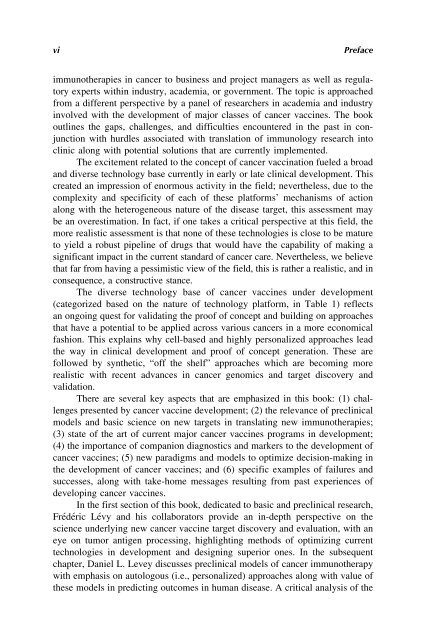Download File - JOHN J. HADDAD, Ph.D.
Download File - JOHN J. HADDAD, Ph.D.
Download File - JOHN J. HADDAD, Ph.D.
You also want an ePaper? Increase the reach of your titles
YUMPU automatically turns print PDFs into web optimized ePapers that Google loves.
vi Preface<br />
immunotherapies in cancer to business and project managers as well as regulatory<br />
experts within industry, academia, or government. The topic is approached<br />
from a different perspective by a panel of researchers in academia and industry<br />
involved with the development of major classes of cancer vaccines. The book<br />
outlines the gaps, challenges, and difficulties encountered in the past in conjunction<br />
with hurdles associated with translation of immunology research into<br />
clinic along with potential solutions that are currently implemented.<br />
The excitement related to the concept of cancer vaccination fueled a broad<br />
and diverse technology base currently in early or late clinical development. This<br />
created an impression of enormous activity in the field; nevertheless, due to the<br />
complexity and specificity of each of these platforms’ mechanisms of action<br />
along with the heterogeneous nature of the disease target, this assessment may<br />
be an overestimation. In fact, if one takes a critical perspective at this field, the<br />
more realistic assessment is that none of these technologies is close to be mature<br />
to yield a robust pipeline of drugs that would have the capability of making a<br />
significant impact in the current standard of cancer care. Nevertheless, we believe<br />
that far from having a pessimistic view of the field, this is rather a realistic, and in<br />
consequence, a constructive stance.<br />
The diverse technology base of cancer vaccines under development<br />
(categorized based on the nature of technology platform, in Table 1) reflects<br />
an ongoing quest for validating the proof of concept and building on approaches<br />
that have a potential to be applied across various cancers in a more economical<br />
fashion. This explains why cell-based and highly personalized approaches lead<br />
the way in clinical development and proof of concept generation. These are<br />
followed by synthetic, “off the shelf” approaches which are becoming more<br />
realistic with recent advances in cancer genomics and target discovery and<br />
validation.<br />
There are several key aspects that are emphasized in this book: (1) challenges<br />
presented by cancer vaccine development; (2) the relevance of preclinical<br />
models and basic science on new targets in translating new immunotherapies;<br />
(3) state of the art of current major cancer vaccines programs in development;<br />
(4) the importance of companion diagnostics and markers to the development of<br />
cancer vaccines; (5) new paradigms and models to optimize decision-making in<br />
the development of cancer vaccines; and (6) specific examples of failures and<br />
successes, along with take-home messages resulting from past experiences of<br />
developing cancer vaccines.<br />
In the first section of this book, dedicated to basic and preclinical research,<br />
Frédéric Lévy and his collaborators provide an in-depth perspective on the<br />
science underlying new cancer vaccine target discovery and evaluation, with an<br />
eye on tumor antigen processing, highlighting methods of optimizing current<br />
technologies in development and designing superior ones. In the subsequent<br />
chapter, Daniel L. Levey discusses preclinical models of cancer immunotherapy<br />
with emphasis on autologous (i.e., personalized) approaches along with value of<br />
these models in predicting outcomes in human disease. A critical analysis of the

















